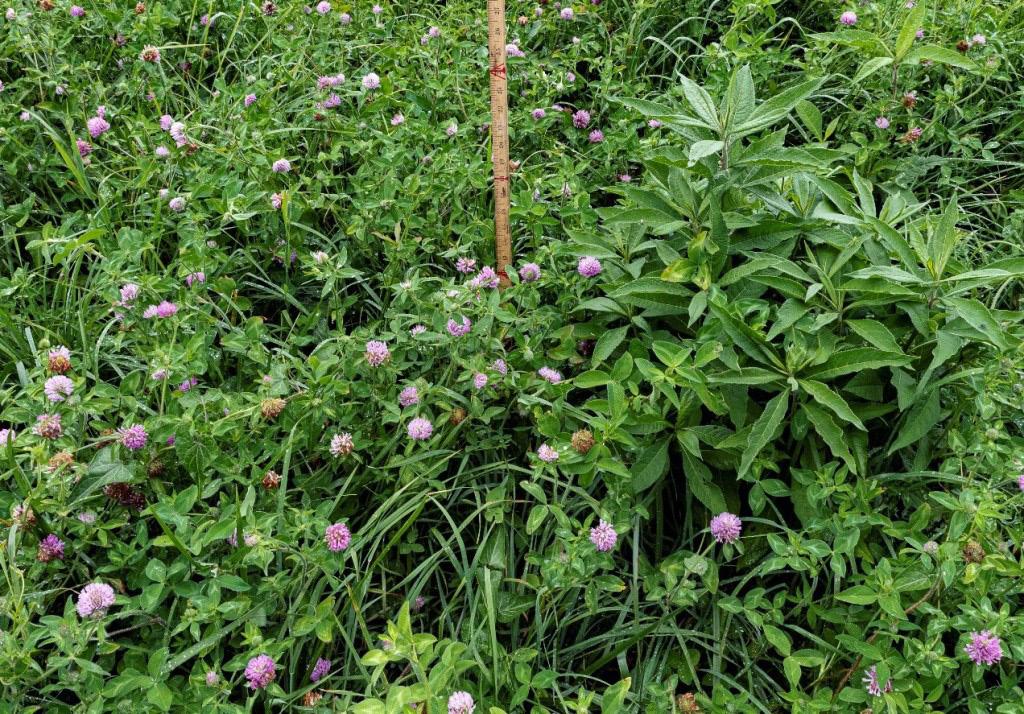
13 minute read
SUPERCEDE TRAD TECHNIQUES?
from Equine Science Review: highlighting research and outreach efforts at the University of Kentucky
WANTED DEAD OR ALIVE – DOES PCR SUPERSEDE TRADITIONAL TECHNIQUES?
As we discussed in a previous issue (PCR – what’s behind this commonly used acronym?) PCR, or the polymerase chain reaction, is an incredibly sensitive technique to detect DNA. The technique is used for parentage testing, in forensic science and is heavily relied upon in medical testing to diagnose diseases, such as those caused by bacteria and viruses. Our desire for rapid and sensitive tests to diagnose infections has pushed us to expand the number of PCR tests available and validated for use. As we discussed before, PCR can be performed in a matter of hours, whereas other techniques can take days to weeks. So why do we even need to retain the more traditional techniques at all when we have this amazing modern age method in our toolkit? Well, as anyone who has watched a crime show on TV can tell you, DNA is a very stable molecule and can be detected easily with modern PCR techniques. This can lead to minute traces of DNA being enough to find the culprit of the crime, but is it as accurate when we are looking for the culprit responsible for disease in an animal? There are a few factors to consider here. The first factor is the incredible stability of the DNA molecule. DNA fragments can exist in the environment for some time and can still be detected via PCR testing if the fragment corresponds the right primer sequence added to the reagent mix as we discussed in the previous article. That brings us to our next considerations. Since we use short (~20 nucleotide) sequences unique enough to identify a specific bacteria or virus, how do we know if these sequences come from a fragment of the genome of interest or the presence of the whole genome? Additionally, do we know if that bacterium is still viable and capable of replicating and causing disease? The answers are not clear cut. Bacteria and viruses can survive in the environment and remain viable for variable periods of time depending on conditions and the veracity of the agent itself. Viruses are obligate intracellular pathogens and, as a result of that, virus isolation techniques are quite involved but do remain the ‘gold standard.’ Techniques to isolate viruses require special lab equipment, skilled staff and can take days to weeks, even when there is considerable knowledge on how to culture that particular virus. Bacteria have traditionally been considered easier to culture in the
Advertisement
PHOTO COURTESY DR. EMMA ADAM. lab and we have a long history of research that has generated knowledge on how to grow certain types of bacteria, prevent overgrowth of fastidious bacteria by those that grow easily in vitro and so on. Bacteria can be difficult to grow if the animal has received antibiotics, present in small numbers and easily overgrown by other bacteria in the sample or prefers conditions that we don’t yet understand or replicate in vitro. As such, whilst culturing bacteria is a more accessible and quicker process than it might be with viruses, it’s not without issues. That said, the ability to demonstrate bacterial growth from a sample is the ultimate demonstration that the bacteria are present, viable and can replicate, making culture still the ‘gold standard.’ Let us consider two real world scenarios. Streptococcus equi subspecies equi, the causative agent of ‘strangles’ is not a commensal
organism (a relationship in which one organism derives food or other benefits from another organism without hurting or helping it) and it is always considered a pathogen when identified by culture or PCR. A PCR test was performed on a mare entering a herd to make sure she was not a carrier of this dangerous organism. The test involved flushing sterile saline into her guttural pouches and catching it in a sterile cup as it ran out of her nostrils. This is a pretty standard technique that allows the saline to interact with the guttural pouch, pharynx and nasal passages. The PCR test came back positive, so the mare was examined and cultures were performed. These cultures turned out to be repeatedly negative, but the washes from her nose were positive on PCR. At a loss, finally the equipment was tested and it became apparent that the farm’s rope twitch was the source of the Streptococcus equi subspecies equi DNA. Biosecurity and disinfection measures were adjusted, and all was well. Not only does this demonstrate the sensitivity of PCR, but also the importance of using more than one testing modality (as well as a reminder about biosecurity being of paramount importance!) A second scenario relates to the presentation of a placenta to the University of Kentucky Veterinary Diagnostic Laboratory that was thought to have an infection caused by a group of organisms collectively termed ‘nocardioform bacteria.’ The placenta had the characteristic physical changes seen in this disease process, the mare had had all the clinical signs consistent with the disease as diagnosed by her veterinarian and the microscopic exam of the tissues were also consistent with the diagnosis. However, nocardioform organisms could not be grown from the placental tissue. The placental sample was positive on PCR testing, however. So how did this occur when everything pointed to the bacterial infection? The deduction was that because the mare had received antibiotics, the bacteria were either dead or inhibited from growing in culture. We don’t know for sure, but this example is one seen in many situations where antibiotic therapy has been instituted and bacteria cannot be cultured. These examples and considerations make it hugely important that we maintain and support labs capable of using advanced techniques to get to the bottom of such issues. Fortunately, we have the resources offered by UK’s Veterinary Diagnostic Laboratory and Gluck Equine Research Center, as well as the clinical expertise of our veterinary community, to ensure we get the best answers possible for our equine population. Each test and each examination are a piece of the jigsaw puzzle that we try to put together to understand disease. It is rare that one single test will deliver the answers 100% of the time.
| Emma Adam, DVM, PhD, DACVIM, DACVS, based at UK’s Gluck Center and Veterinary Diagnostic Lab, is responsible for research and serves as veterinary industry liaison. Jackie Smith, MSc, PhD, MACE, Dipl AVES, is an epidemiologist based at the UK Veterinary Diagnostic Lab.
UK AG EQUINE PROGRAMS LAUNCHES NEW WEBSITE

UK Ag Equine Programs unveiled a new website this month, coinciding with the start of a new semester. The updated site includes increased functionality and resources for students, horse owners and industry professionals. Visit https:// equine.ca.uky.edu/ to see what’s new!
UNDERGRAD RESEARCH PROJECT STUDIES HORSES’ INCLINATION TO SEEK SHADE AT CERTAIN TEMPS AND TIMES OF DAY IN CENTRAL KENTUCKY
In the last Equine Science Review, an undergraduate independent research project that examined shade seeking behavior in Texas was discussed. A similar study was done in Central Kentucky by Kassie Rutherford, an undergraduate equine junior at the University of Kentucky. Rutherford completed an independent research project observing horses in Midway, Kentucky. She also worked with Camie Heleski, PhD, senior lecturer within the equine undergraduate degree program, on a quest to learn more about horses’ desire to seek shade during different times of the day.
Rutherford conducted this research primarily at Heronwood Farm and surrounding facilities because of their wide array of breeds, ages and disciplines.
“Right now I’m still on my horse, and I’m looking at two horses that belong to a racehorse trainer, two other horses that belong to the owner and I’m looking at a different property with mares and foals. That’s what was so great about where I was at, because I could collect information while I rode,” Rutherford said.
“I loved how Kassie incorporated her data collection into moving around the farm, sometimes exercising her horses simultaneously,” Heleski said. “She was really diligent about entering the data into her cell phone so she could do both.”
During her project, Rutherford observed at what point of the day was it hot enough for horses to seek out shade. This was to establish if there were temperature
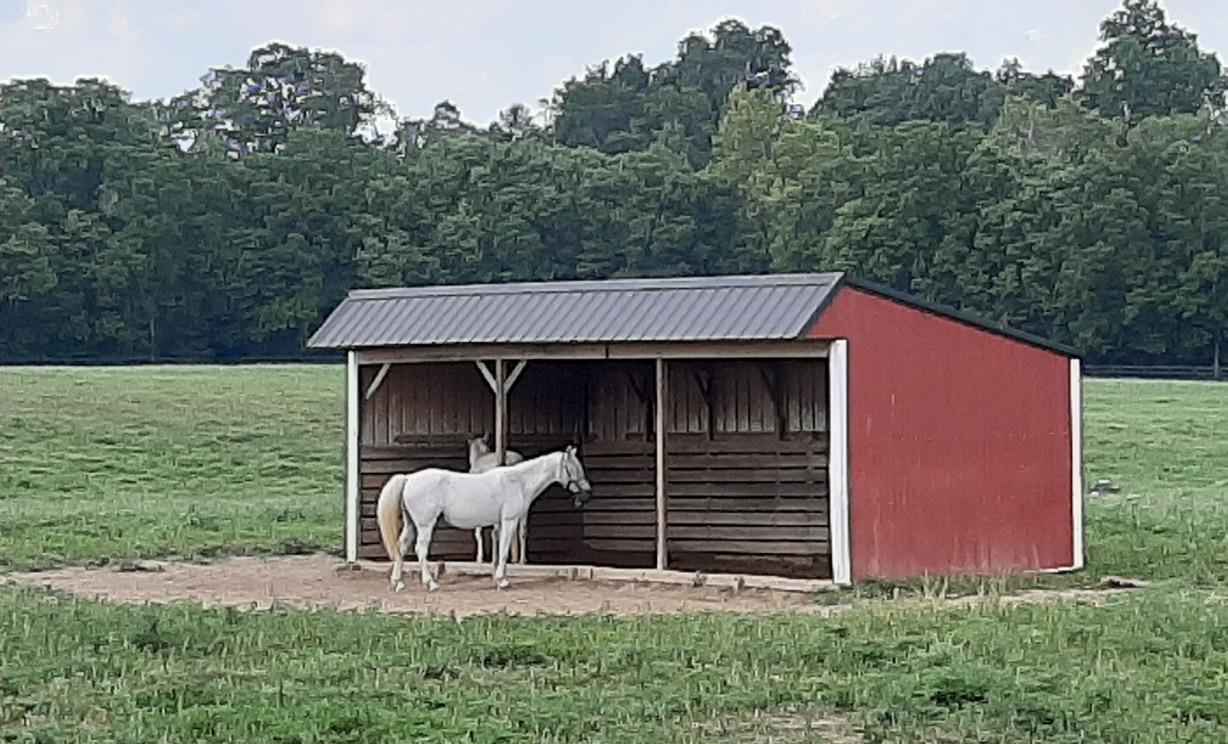
or time of day patterns. Like Underwood in the Texas study, Rutherford was interested in seeing if the horses would seek shade in temperatures greater than 85 degrees Fahrenheit.
“Some of it was a pattern, but I think it had a lot to do with where the sun was, what the actual UVIndex was and if there were clouds covering the sun. Because even in the morning when it was full sun, they were almost never in the shelter,” Rutherford said.
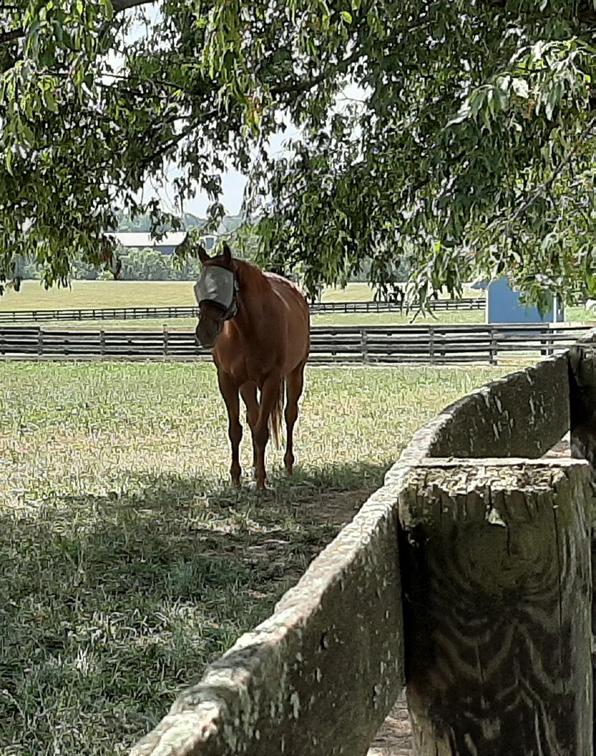
PHOTO COURTESY KASSIE RUTHERFORD. PHOTO COURTESY KASSIE RUTHERFORD.
When asked about her findings, she said that she believed it wasn’t necessarily due to the positioning of the sun in the sky, but more so the hottest point of the day.
“What I found was that it wasn’t where the sun was the highest in the sky, it was actually the hottest part of the day, which is typically, from what I found, between 3 to 6 p.m. It was between those times that the horses started to seek out shelter,” Rutherford said.
“This echoes my casual observations over the summer,” Heleski said. “Kassie seemed to see that sometimes it also had a lot to do with the group dynamics of the herd on a per pasture basis; sometimes it seemed that the heat was eliciting shade seeking behavior in one pasture, but just one pasture over, it might be that none of the horses were seeking shade.”
Rutherford was also interested in learning if there was a preference in types of shade. For example, if horses would seek out manmade shelter versus trees, and
what the difference between those might be.
“I would walk out to my horses’ field and I would stand in the shelter with a thermometer, and there were several days that it was 8-10 degrees hotter within the shelter, even though it was shady. So then, they would rather stand under tree shade because of the breeze and the fresh air that they got that was inhibited by the shelter,” Rutherford said.
“I do feel this is a very important point; some people who build sheds for their horses get frustrated that the horses don’t seem to use the shade much in the summer. But, unless we know the actual temperature inside the shelter, it’s hard to say the horses aren’t using common sense by avoiding the shelter during peak heat times,” Heleski said.
When asked about Underwood’s findings about the horses seeking shade due to the UV index, Rutherford agreed that it could be a possible explanation, but that it wasn’t something she directly measured.
“You know how there’s days
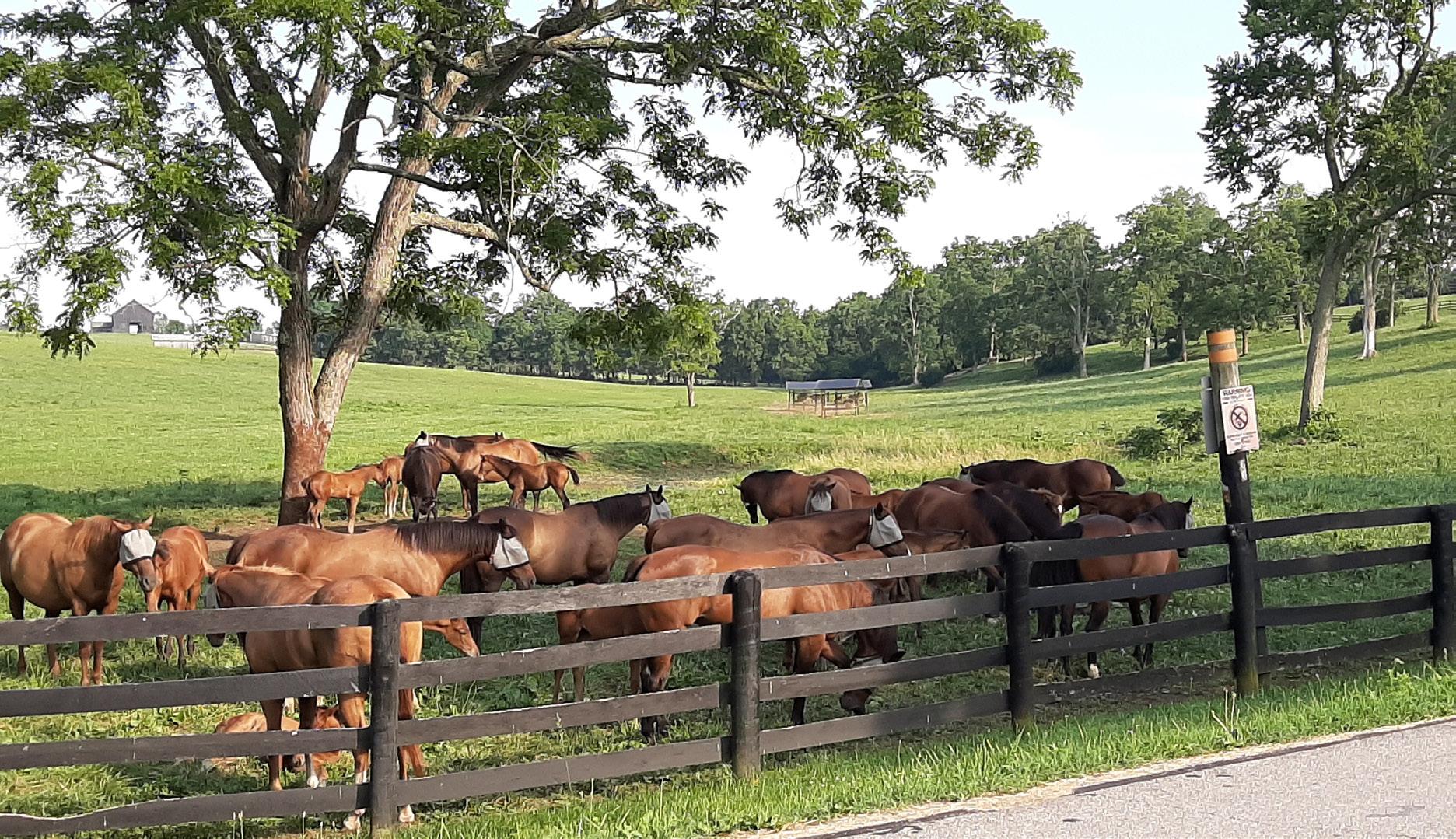
where it’s bright outside, but it might not actually be full sun? It could be that those are the days that the UV index is a little bit lower. I would agree with her that the UV index plays a role if they want to be in the shelter or not,” Rutherford said.
PHOTO COURTESY KASSIE RUTHERFORD.
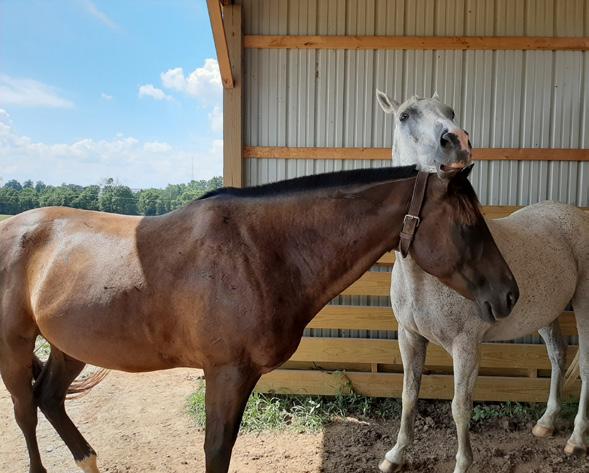
Rutherford said her experience with undergraduate research has strongly impacted her life and future decisions.
“I definitely found myself outside of my research looking at farms and how their horses were responding to the heat, if they were seeking out shade,” she said. “One of the things that I’ve found with this degree, is that even if I don’t get a career in the equine industry,
PHOTO COURTESY KASSIE RUTHERFORD.
everything I learned, I can apply to my own life as a horse owner. This research has already helped me to decide what kind of shelter I want to have for my horses on my own property.”
She said that the level of responsibility that is given to students in undergraduate research is extremely important.
“First of all, you’re accountable for something that’s more than just homework. It’s under your prerogative to find that research, find the horses that you are looking for and do it. It just gives a certain level of responsibility to undergrads doing this research, so I think it’s really good. It’s good to have a project that you don’t have a lot of guidance on, it’s up to you how you conduct it,” Rutherford said.
| Sabrina Jacobs, a senior majoring in equine science and management and minoring in wildlife biology and management, is a communications and student relations intern with UK Ag Equine Programs.
PASTURE RENOVATIONS WILL HELP HORSE FARM IMPLEMENT ROTATIONAL GRAZING
Spendthrift Farm is one of Lexington’s iconic Thoroughbred breeding and racing operations. Due to recent expansion, the farm wanted to renovate some unused fields and develop them into pastures to use in a rotational grazing system. They turned to forage experts with the Horse Pasture Evaluation Program in the University of Kentucky College of Agriculture, Food and Environment for their recommendations. “The Horse Pasture Evaluation Program is a good tool for all horse farms to use,” said Robbie Moreland, Spendthrift maintenance manager. “It gives us options and guidelines that we can use to develop the land to suit our needs.” Spendthrift Farm has worked with Krista Lea, MS, UK research analyst, and Ray Smith, PhD, UK forage extension specialist, for a number of years to evaluate and renovate fields on their main farm through the program. “They have done a good job of implementing grazing rotations, as well as removing fescue from some key broodmare fields and having good success with over seeding,” Lea said. “This was our first endeavor with them trying to completely re-establish a pasture.” Thick, lush grasses grow on the renovated pasture at Spendthrift Farm. Photo by Katie Pratt, UK agricultural communications. The pasture renovation that began in summer 2019 includes 130 acres of an adjoining property the farm purchased a few years back but had not fully incorporated into their operation. “The land was physically rough, and the grass was consumed by weeds. We decided the best thing to do was just to start completely over again and develop a grass pasture,” Moreland said. Farm management wanted to es
HORSES GRAZE AT SPENDTHRIFT FARM. THE FARM HAS WORKED WITH THE UK HORSE PASTURE EVALUATION PROGRAM FOR SEVERAL YEARS TO MAKE SURE ITS HORSES HAVE ACCESS TO HIGH QUALITY FORAGES. PHOTO BY KATIE PRATT, UK AGRICULTURAL COMMUNICATIONS.
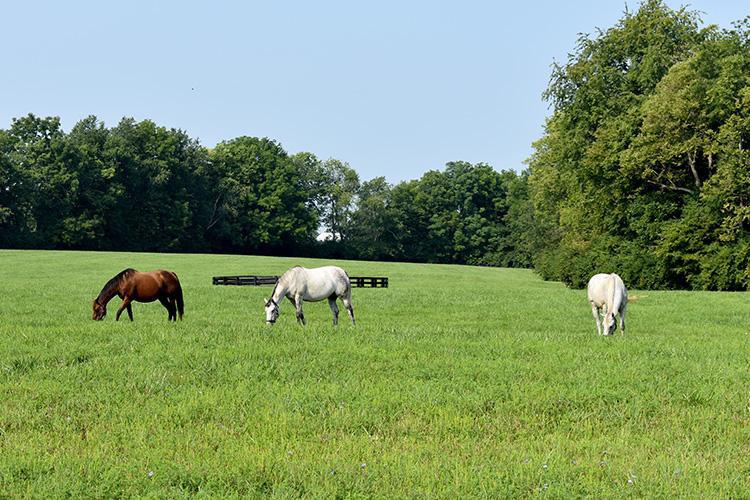
tablish pastures that were healthy and beneficial for their horses and good for the natural environment. In 2019, they opted to kill off the existing vegetation using tillage, rather than a traditional field burndown with glyphosate. They reseeded the fields with a mixture of bluegrass, orchardgrass and perennial ryegrass. Even though Central Kentucky experienced a drought last fall, the seed germinated and created a lush stand of grass. Moreland said Spendthrift plans to start fencing the renovated pasture and building a barn this fall, with the goal of allowing horses to graze in the pasture in the spring. Moreland said it was important to the farm to slowly and methodically prepare the ground for grazing. “We would like to keep these pastures lush,” Moreland said. “To do this, we are going to use it as a pasture rotation with our main farm. The new pastures and barn will be used for our mares and weanlings.” Spendthrift Farm is just one of the farms the Horse Pasture Evaluation Program advises each year. From its beginnings in 2005 to 2019, the program conducted more than 250 evaluations on horse farms of all sizes and breeds. In 2020, Lea and her student interns have evaluated nearly 30 farms. This is the highest number of operations they have serviced in any one year. “A high-quality pasture is beneficial to both horses and the environment,” Lea said. “It allows horses to select the best possible forage and stay away from undesirable weeds. We know that good quality pasture maintains a lot of cover, and that reduces soil erosion, prevents nutrients from leaching off that pasture and maintains the soil that is there.” More information about the program can be found here. Video for this story can be found here.
| Katie Pratt is an agricultural communications specialist within UK’s College of Agriculture, Food and Environment. Source: Sept. 3 news relese.


